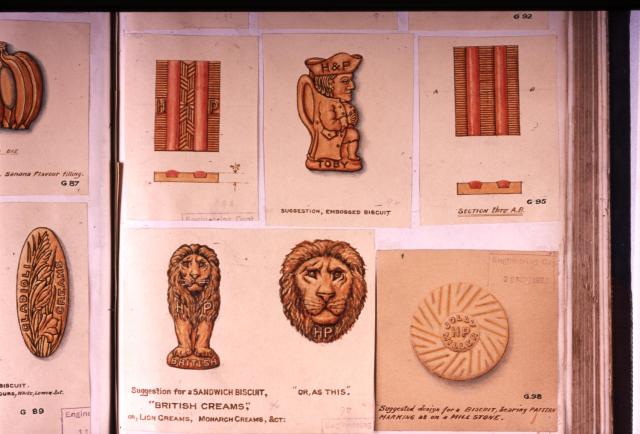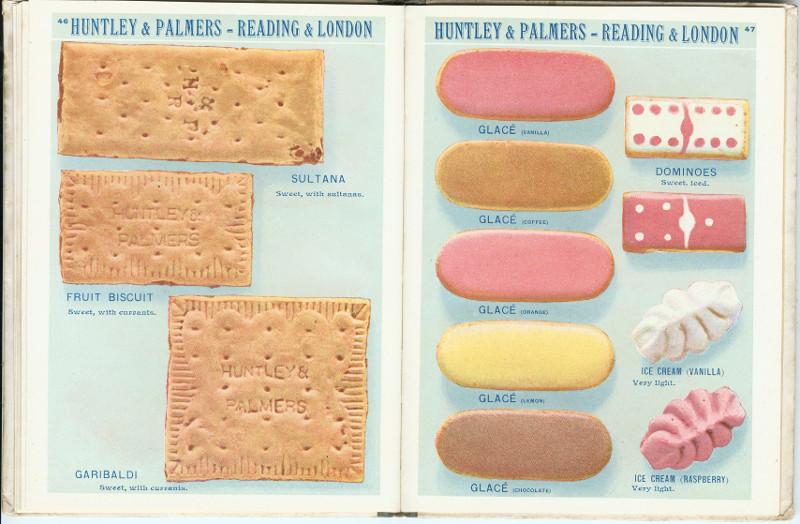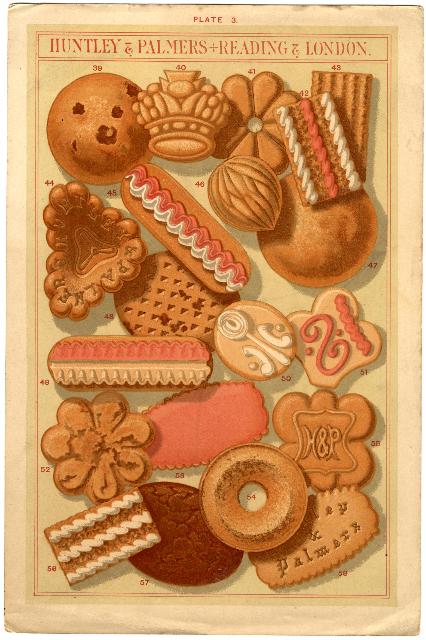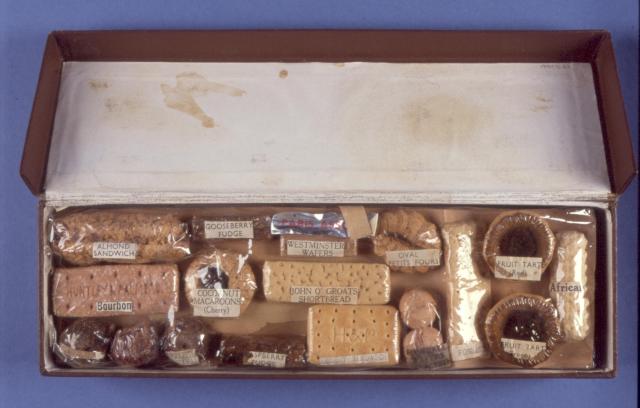Biscuits - ancient and modern
The biscuits eaten by sailors in the British Navy in the nineteenth century were as hard as floor-tiles - and probably tasted like floor-tiles too! They had to be mashed up in water to form gruel in order to be edible. Today, by contrast, many biscuits are very sweet and have a thick coat of chocolate. This change from hard, unsweet biscuits to softer and much sweeter kinds is reflected in the varieties of biscuits made by Huntley and Palmers in the 130 years that they were active.

An unknown soldier wrote on this World War I army biscuit, 'A Christmas day tea snack, from the trenches, 1917'. (REDMG : 1997.162.7)
Changing varieties
In the 1840s many of the biscuits that Huntley & Palmers made reflected kinds that would have been produced in the home. Soon, however, they had a large Experimental Department to devise new varieties. Many of the kinds still eaten today - Ginger Nuts, for example - are probably not that different from the biscuits of the same name made in the nineteenth century. Others, though, which were created by the Experimental Department had a short lifespan. Fortunately, we often know what they look like, either because they were illustrated in catalogues or because, in a few cases, actual biscuits have survived in display cases - often in surprisingly good condition.

Until World War II, Huntley & Palmers were devising biscuits in hundreds of different of shapes and sizes. The war led to many varieties being dropped due to rationing and shortages and many products were not revived afterwards. (REDMG : 1997.162.89)
What did they taste like?
The catalogues remind us that a large proportion of Huntley & Palmers' output was devoted to 'Unsweetened Kinds' (which most people would today think of as forms of Cream Cracker) and 'Slightly Sweetened Kinds' (which today would be represented by, for example, Arrowroot or Garibaldi biscuits). Before 1945 'Sweet Kinds' often had a layer of crisp icing, but they were still fairly hard and only very rarely had an outer layer of chocolate.

This lavishly illustrated catalogue includes a bird's eye-view of the factory, showing the horse-drawn trams that run between Brock Barracks and Palmer Park until they were replaced by electric trams in 1903. (REDMG : 1999.2.52)
An experiment to try at home
If you would like to find out what early biscuits tasted like, here are a few of Huntley & Palmers' recipes from the Victorian and Edwardian periods. They might not be as sweet as a modern chocolate biscuit, but they were probably somewhat better for your teeth!

A glass-topped box of Currant Shortcake biscuits from the 1930s. This kind of box was part of Huntley and Palmers' attempts to maintain high display standards whether their products were in a small family grocer or a large chain. (REDMG : 1997.162.1)
Long Jamaica biscuits (1865)
The factory recipe ingredients are -
26 lbs White Flour
4 lbs Butter
5 lbs Loaf Sugar
5 pints Milk
For home baking scale this down to -
570 grams Plain Flour
100 grams Butter
110 grams Caster Sugar
1/4 pints Milk
Crumble the butter into the flour. Add the other ingredients. Roll out and cut into the shape of your choice. Bake in an oven at Gas 5 (190 C) until golden brown. This makes a very plain, pastry-like biscuit. To give it a bit more of a 'Jamaican' flavour you could substitute Muscovado sugar.

The biscuits illustrated in this 1890s catalogue plate include 39 Richmond, 40 Crown Balmoral, 44 Toy Cracknel, 45 Clifton, 46 Walnut, 47 Orange Drop, 49 Clifton, 51 Filbert Rout, 54 Ringlet, 55 Harrow, 57 Rich Traveller & 58 Venice (REDMG : 1997.82.279)
Nice (1904)
The factory recipe ingredients are -
120lbs Seconds Flour
48lbs Lawn Sugar
4lbs Best Butter
4lbs White Butter
16lbs Coconut
24 pints New Milk
8oz Vanilla Sugars
1 ½ oz Stuff
6oz Soda
For home baking scale this down to -
570 grams Plain Flour
250 grams Caster Sugar
40 grams Butter
75 grams Coconut
1/4 pint Milk
1 teaspoon Vanilla Essence
1 teaspoon Baking Soda
Crumble the butter into the flour. Add the other ingredients. Stand for half an hour. This makes a very stiff, dry dough, but roll out and cut into the shape of your choice. Bake in an oven at Gas 5 (190C) until golden brown. This makes a more flavoursome biscuit than the previous recipe!

Paris Assorted was a luxury assortment of fancy biscuits, marzipans and chocolate confections. It was probably introduced in the 1930s, though rationing meant that production was ceased during the Second World War. (REDMG : 1997.162.11)
Return to the Huntley & Palmers homepage, or head on to the next section.





